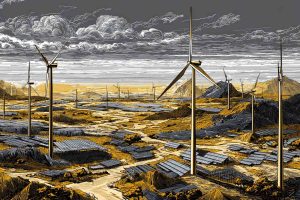Beyond the fad: how 3D printing found its place

A spark of radical possibility
The idea of building objects layer by layer instead of cutting, molding, or casting them has always carried a certain futuristic appeal. In 1983, Charles Hull developed the first stereolithography apparatus, a machine that could solidify liquid resin with ultraviolet light, bringing digital blueprints into physical form (The birth of stereolithography, Hull). This was the birth of 3D printing, though at the time it was viewed as a highly specialized tool for engineers and designers. For industries like automotive and aerospace, the technology offered a way to produce prototypes in days rather than weeks, accelerating product development.
During these early years, 3D printing was not glamorous. Machines were expensive, slow, and required expert operators. Yet the conceptual leap was profound: objects could be produced without molds, tools, or subtractive machining. To its pioneers, this hinted at a future where manufacturing itself might be redefined.
By the late 1990s and early 2000s, as personal computers and the internet reshaped everyday life, visionaries began to imagine a similar revolution in the physical world. Why stop at digital democratization when material production itself could be decentralized? This shift in narrative would lay the groundwork for the boom that followed.
The promise of democratized manufacturing
In the early 2000s, a cultural and technological convergence created fertile soil for the 3D printing hype. The rise of the open-source movement, the spread of DIY maker culture, and the falling costs of electronics made people more receptive to the idea that sophisticated technologies could enter the home. Initiatives like the RepRap project, launched in 2005 by Adrian Bowyer, sought to create self-replicating 3D printers capable of printing most of their own components (RepRap: The Replicating Rapid Prototyper, Bowyer). It embodied a utopian vision: machines that could duplicate themselves and empower users to produce anything they needed.
The media eagerly embraced these stories. Headlines announced a future where consumers would no longer be passive buyers but active producers. If you broke a cup, you could simply print another. Designers could sell digital files instead of physical products. Entire industries, from retail to logistics, were supposedly under threat. The metaphor was clear: just as the printing press democratized information, 3D printing would democratize production (The Maker Movement Manifesto, Hatch).
By the early 2010s, the hype reached fever pitch. Companies like MakerBot became icons of this revolution. Consumer-focused machines were marketed as must-have gadgets, and online communities like Thingiverse offered thousands of free designs to print at home. Investors, captivated by the narrative, poured money into the sector. Gartner placed 3D printing technologies near the peak of its Hype Cycle (Hype Cycle for Emerging Technologies, Gartner), signaling both widespread attention and the risk of disillusionment.
Speculation and the stock market bubble
Wall Street was quick to seize on the excitement. Companies such as 3D Systems and Stratasys saw their stock prices soar as retail investors imagined the dawn of a new industrial age. Between 2012 and 2014, valuations of these companies multiplied, despite relatively modest revenues (Additive manufacturing: hype, hope, and reality, Wohlers). Analysts compared the moment to the early internet boom, suggesting that traditional manufacturing and supply chains might soon be disrupted.
But, as with many speculative bubbles, the fundamentals could not sustain the narrative. Revenue growth lagged behind the soaring expectations, and the consumer market proved far smaller than forecasted. When investors realized that selling desktop 3D printers was not as profitable or revolutionary as promised, stock prices collapsed. For some, 3D printing became synonymous with overhype and disappointment.
The consumer letdown
The idea that every household would one day own a 3D printer turned out to be more fantasy than reality. Unlike personal computers, which provided clear utility through word processing, internet browsing, and communication, consumer 3D printers offered limited practical value.
Most machines were difficult to calibrate, required constant maintenance, and produced objects with poor surface finish and low durability (Desktop 3D printing: an assessment of the consumer market, Lipson). Printing even a small item could take hours, and users often found themselves battling clogged nozzles, warped prints, or misaligned axes.
Moreover, the material ecosystem was restrictive. Common filaments like PLA or ABS could only create simple plastic parts, many of which were brittle and aesthetically underwhelming. Printing useful, durable household goods was far more challenging than expected.
In practice, consumer printers mostly churned out trinkets, figurines, and prototypes rather than essential tools or replacement parts. For hobbyists and enthusiasts, this was exciting. For the average household, it was a letdown. Once the novelty wore off, many printers ended up gathering dust.
The collapse of MakerBot symbolized this broader consumer disappointment. Initially hailed as the Apple of 3D printing, the company suffered from quality issues, lawsuits, and strategic missteps (MakerBot’s decline and the 3D printing bubble, The Verge). By the mid-2010s, it had dramatically downsized, leaving many early adopters disillusioned.
The pivot to industrial strength
Yet the story of 3D printing did not end with the bursting of the consumer bubble. In fact, the collapse of inflated expectations cleared the path for a more grounded, sustainable phase of development. The real promise of additive manufacturing was not in living rooms but in industries where complexity, customization, and rapid prototyping offered tangible advantages.
Aerospace companies like Boeing and GE began using 3D printing to create lightweight, high-performance components that could not easily be manufactured with traditional methods. GE Aviation, for example, developed fuel nozzles for jet engines that were not only lighter but also consolidated multiple parts into a single printed piece, improving durability and reducing assembly costs (How GE is using 3D printing for jet engines, GE Reports).
In healthcare, 3D printing opened possibilities for custom implants, prosthetics, and dental applications. Orthopedic surgeons could design patient-specific implants tailored to individual anatomies, while dentists used 3D printers to produce crowns, aligners, and surgical guides with precision (3D printing in healthcare: emerging applications, Ventola).
Automotive companies like BMW and Ford integrated additive manufacturing into prototyping and tooling, accelerating development cycles and lowering costs (Additive manufacturing in the automotive industry, McKinsey). Even in fashion and architecture, designers explored new geometries and lightweight structures previously impossible with conventional techniques.
This industrial pivot reshaped the narrative. Instead of replacing traditional manufacturing wholesale, 3D printing became a complementary technology. It was not about printing everything, everywhere, but about printing the right things in the right contexts.
Expanding materials and methods
One of the most important factors in 3D printing’s maturation has been the diversification of materials and techniques. Early consumer printers were limited to plastics like PLA, but industrial systems have expanded into metals, ceramics, composites, and even biological materials.
Metal additive manufacturing, particularly processes like selective laser melting (SLM) and electron beam melting (EBM), has enabled the production of high-strength parts for aerospace and medical applications (Additive manufacturing of metals, DebRoy). Companies like EOS and Desktop Metal have pushed forward in this domain, making it possible to produce complex metal geometries that would be costly or impossible to machine conventionally.
In the biomedical field, researchers are experimenting with bioprinting, using living cells to create tissue-like structures (3D bioprinting of tissues and organs, Murphy and Atala). While printing entire organs remains a distant goal, advances in this area hint at future medical breakthroughs.
Large-scale 3D printing has also gained attention in construction. Projects experimenting with 3D-printed houses and bridges demonstrate the potential of additive manufacturing to reshape how we think about infrastructure, although these remain early-stage and often experimental (3D printing in construction: current status and future prospects, Buswell).
By expanding both materials and methods, 3D printing has shed its image as a toy-like technology and become a versatile tool across industries.
The hype cycle revisited
The trajectory of 3D printing mirrors the pattern described by Gartner’s Hype Cycle: a breakthrough innovation generates excitement, hype inflates expectations, disillusionment sets in, and eventually a more measured adoption emerges (Understanding Gartner’s Hype Cycle, Fenn).
In hindsight, the consumer hype of the early 2010s was never sustainable. It was driven by utopian thinking and marketing excess rather than real-world utility. Yet this phase was not entirely wasted. It attracted funding, inspired a generation of makers, and pushed the technology into public consciousness.
The subsequent disillusionment, while painful for investors and startups, forced the industry to refocus on areas where 3D printing genuinely adds value. Today, the technology sits in the “Slope of Enlightenment,” where adoption grows steadily and use cases expand incrementally.
Why the “fad” label misses the point
Critics often point to 3D printing as an example of a fad that promised the world but delivered little. This judgment is partly true: the household revolution did not materialize, and consumer enthusiasm fizzled. But reducing the story to a failed fad ignores the genuine transformations taking place in industries that quietly adopted the technology.
Unlike fleeting consumer crazes, 3D printing has proven durable, adapting and evolving beyond its initial hype. The technology is not a replacement for traditional manufacturing but a complementary addition. It thrives in niches where complexity, customization, or speed outweigh mass-production efficiency (The state of 3D printing 2024, Sculpteo).
Calling 3D printing a fad reflects a misunderstanding of how technological revolutions unfold. They rarely follow a straight line from promise to dominance. Instead, they move in cycles of hype, disappointment, and eventual integration.
Lessons for future technologies
The story of 3D printing offers valuable lessons for how we approach emerging technologies more broadly. Artificial intelligence, blockchain, virtual reality, and other fields often undergo similar cycles of hype and correction. The public imagination tends to overshoot reality, while investors chase quick returns. When the inevitable reality check arrives, some declare the technology dead.
Yet, as with 3D printing, the long-term impact may be profound once the noise fades and practical use cases are established. The challenge lies in distinguishing between short-term hype and long-term value (Technological revolutions and financial capital, Perez).
For policymakers, investors, and innovators, the trajectory of 3D printing underscores the importance of patience and realism. Not every promise will be fulfilled, but that does not mean the underlying innovation is worthless.
A technology in quiet bloom
Today, 3D printing is less visible in mainstream headlines, but it is more embedded than ever in industries that matter. From lightweight aerospace components to custom dental implants, from rapid prototyping in automotive design to experimental projects in bioprinting and construction, the technology has carved out a permanent role.
It has also shifted the way companies think about design. Engineers now approach problems with additive manufacturing in mind, considering geometries and solutions that would have been dismissed as impractical in the past. This design freedom, coupled with ongoing improvements in speed and material science, continues to expand the boundaries of what is possible.
For consumers, the revolution may never have happened in the living room. But indirectly, they benefit from safer airplanes, faster medical treatments, and products that reach the market more quickly thanks to 3D-printed prototypes and tools.
Conclusion: beyond the fad
The rise and fall of 3D printing hype tells a familiar story of technological overpromise and disillusionment. But unlike many true fads, 3D printing did not vanish when expectations collapsed. Instead, it matured.
What began as a futuristic fantasy of household factories has evolved into a versatile, reliable tool for industries that value complexity, customization, and efficiency. The real transformation was never about printing your own coffee mug at home but about enabling engineers, doctors, and manufacturers to design and produce in ways that were previously impossible.
3D printing is not the revolution that was promised in the headlines of 2012, but it is a revolution nonetheless, unfolding quietly in labs, factories, and hospitals. The hype may have faded, but the impact endures. The lesson is clear: behind every so-called “fad” may lie a technology that simply needed time, patience, and the right context to find its place.


















